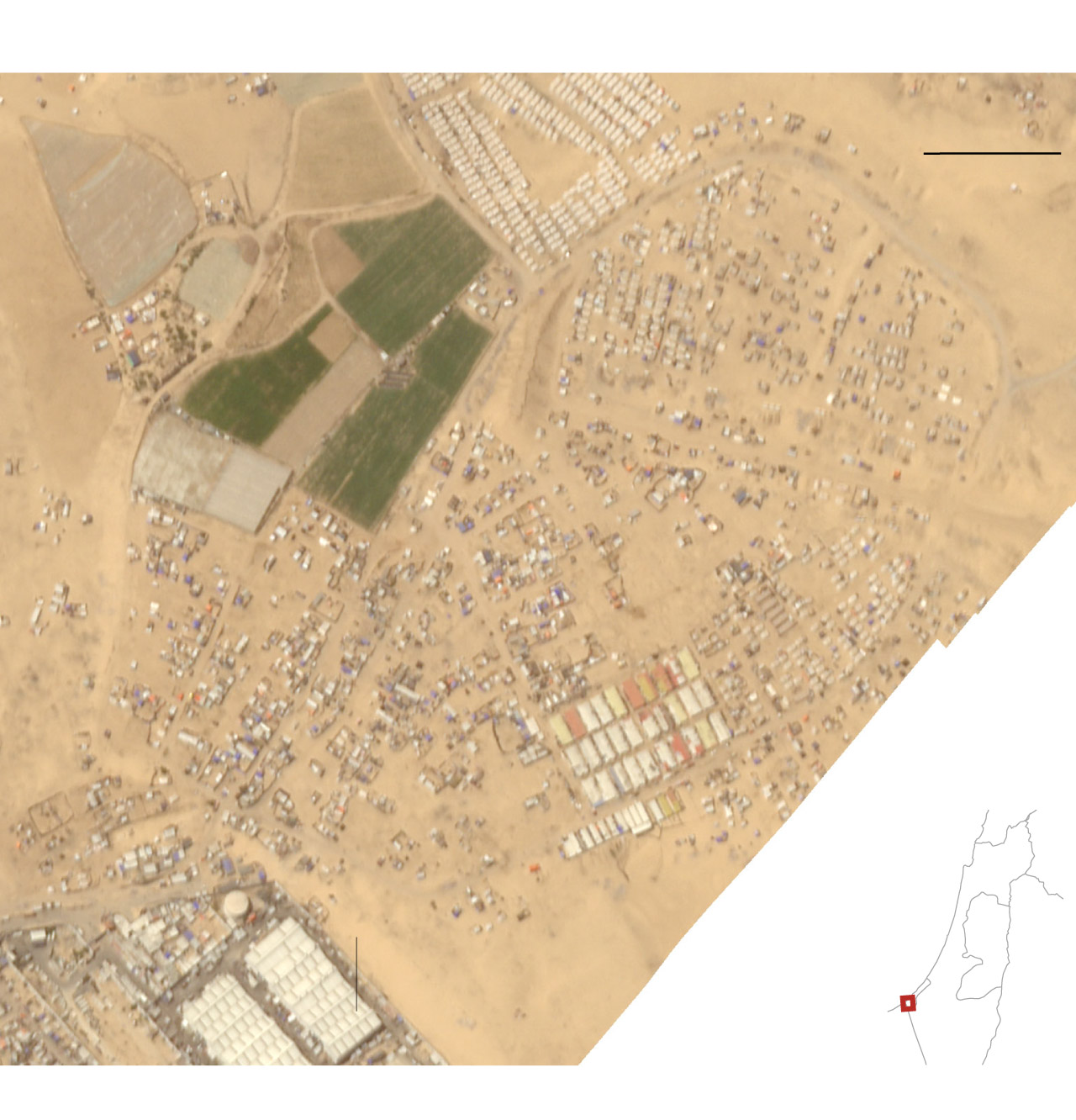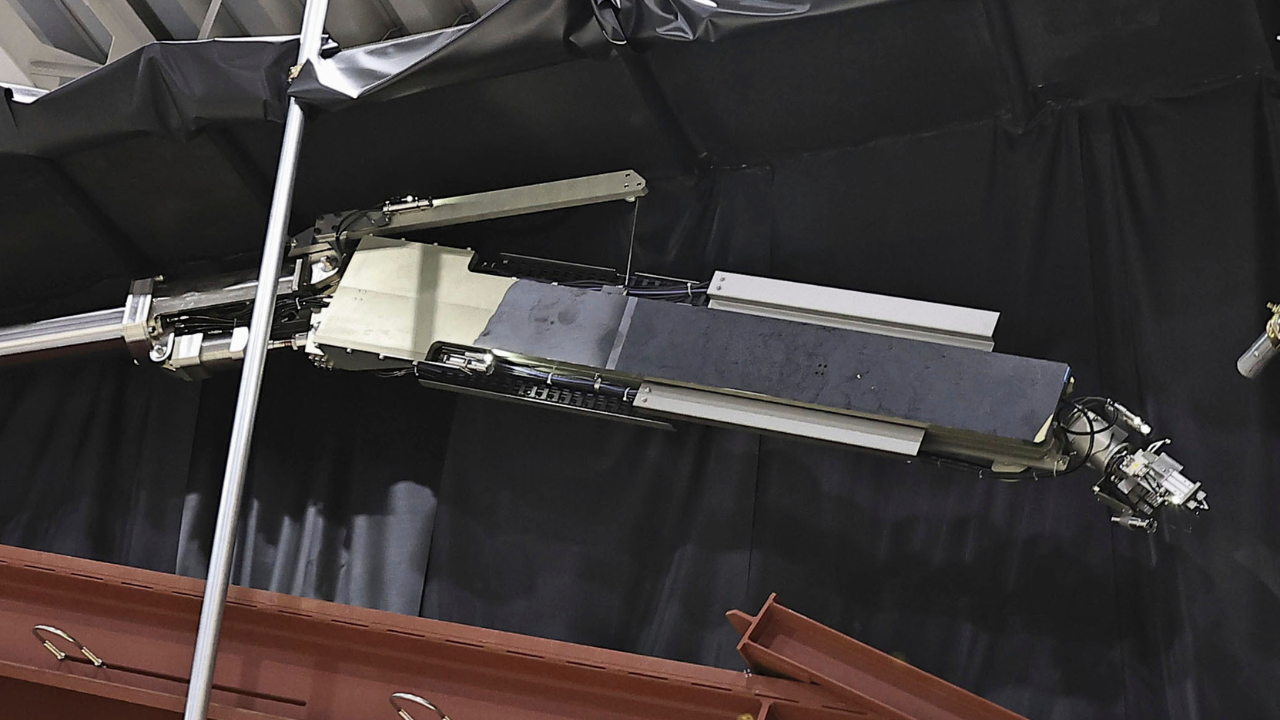JERUSALEM — A deadly Israeli airstrike on a tent camp in Rafah late Sunday drew widespread international condemnation Monday — focusing further scrutiny on Israel’s controversial offensive against Hamas in the south and the desperate plight of Gaza’s civilians.
Washington
Behind the AP Top 25 ballot at midseason: Who should be No. 1 now? Who will finish on top?

The college football regular season has reached its halfway point, and not a ton has changed in the AP Top 25. So, will there be surprises to come? This week’s midseason edition of the column assesses where the rankings have been, where they are now and where they might be going.
1. I find myself with a revolving door of No. 1s. I switched from Georgia to Texas before the Longhorns promptly lost to Oklahoma. And now, after putting Georgia back on top, I made another change this week: Washington has earned my vote.
I considered it a few weeks ago, when I pushed the Huskies all the way up to No. 2, but they lacked a true resume-making win. Now they have it against Oregon, a result better than anything Georgia has done thus far, on top of having arguably the best offense in the country behind Michael Penix Jr. and a deep receiving corps.
Meanwhile, Georgia sleepwalked through much of the afternoon against Vanderbilt, and its lackluster performance against Auburn doesn’t look any better after the Tigers were pummeled by LSU. Throw in the fact that dominating Kentucky also looks less impressive after the Wildcats were soundly beaten by Missouri, and I don’t believe Georgia needs to be No. 1 by default.
I thought a few more people might join me in voting Washington No. 1, but just one other voter did it. Most of the Georgia defectors have gone to Michigan, which has 16 votes despite playing a schedule even more forgettable than Georgia’s to this point.
Not that I’m against thinking that Michigan is the best team. But we’ll get to that later.
2. Georgia was ranked No. 1 at midseason in each of the past two years en route to its national championships. Fourteen of the past 16 national champions were ranked in the top five in mid-October, the only exceptions being 2014 Ohio State (No. 13) and 2015 Alabama (No. 8). In fact, of the 38 national champions since 1989 (including shared titles), 32 were ranked in the top five of the AP poll at this point in October, including 11 at No. 1.
Since the poll expanded to 25 teams in 1989, the only national champions that were ranked outside the top 10 at midseason beyond 2014 Ohio State were both in 1990: split champs Colorado (No. 14) and Georgia Tech (No. 11). In other words, history says the national champion is almost certainly in the top 10 right now and is likely to be one of Georgia, Michigan, Ohio State, Florida State and Washington.
Washington is up to No. 5 after starting 10th. Should it be even higher? (Steven Bisig / USA Today)
3. The word “parity” has been thrown around plenty when analyzing this season, including in this space. But parity can mean many things. In the case of this season, it’s the feeling that there are more national championship contenders than usual, or at least more than there have been for most of the College Football Playoff era. The top tier of teams feels bunched up, and nobody is running away from the pack.
But it’s also been a chalky season. Through seven weeks, there has been only one win by an unranked team against an AP top-10 team at the time of the game: Duke over Clemson on Labor Day. Substantial upsets have been few and far between, and we haven’t had anything resembling the semi-annual chaos Saturday we all know and love.
In each of the past two regular seasons, there were 12 wins by unranked teams against top-10 opponents. That included five in the first half of 2022 and seven in the first half of 2021. The gold standard for chaos was, of course, 2007, which featured 21 wins by unranked teams against top-10 opponents in the regular season, including four on Sept. 29 alone. On the other end of the spectrum: 1997, which featured just three such upsets.
This season has had a handful of memorable games — including Washington-Oregon and Oklahoma-Texas rivalry classics the past two weeks — but truly shocking results have been lacking.
4. Voters were historically terrible at predicting how the season would play out last year, when just 10 teams both started and finished the season ranked in the AP poll — a record low since 1989 poll expansion. That number was 13 at midseason.
Perhaps things are evening out. This midseason? Twenty of 25 teams that were ranked in August are ranked today after Tulane and Iowa re-joined the poll. The only preseason ranked teams not ranked in this week’s poll are Clemson, Kansas State, TCU, Wisconsin and Texas A&M. Clemson could easily find itself back in the poll next week, too, if it beats Miami.
On average, 15.5 preseason ranked teams have finished ranked in the Top 25 era, with a record of 20 doing so in 1996.
5. In each of the past three seasons, three preseason top-10 teams finished unranked. The average since 1989 is 1.7, though zero did so as recently as 2019. LSU and Clemson are the only two-loss teams that began the season in the top 10, though both do have multiple chances for losses down the stretch. I’d bet on at least one finishing unranked.
An average of 2.1 preseason unranked teams have finished in the top 10 since 1989. Five did so last year, with four in the top 10 at midseason. At midseason this year? The ranked teams that started outside the poll are No. 16 Duke, No. 20 Missouri, No. 21 Louisville, No. 22 Air Force and No. 25 UCLA. Some noteworthy breakthroughs, but not exactly a list of upstarts ready to challenge for a Playoff spot.
6. The season has also lacked marquee games, with Florida State-LSU, Ohio State-Notre Dame and Oregon-Washington the only top-10 matchups at the time of the game. Based on current rankings, there are three top-10 matchups the rest of the regular season, all in the Big Ten East: Penn State at Ohio State on Saturday, Michigan at Penn State on Nov. 11 and Ohio State at Michigan on Nov. 25.

No. 3 Ohio State hosts No. 7 Penn State on Saturday. (Matthew O’Haren / USA Today)
7. So when will unpredictability arrive? Keep an eye on Saturday, Nov. 4, a day that features plenty of potential traps, from Penn State at Maryland to Florida State at Pitt to Oklahoma at Oklahoma State to Kansas State at Texas to Georgia vs. Missouri, among others — on top of LSU at Alabama, Notre Dame at Clemson and Washington at USC.
The next week, Nov. 11, also brings plenty of intrigue, headlined by Michigan at Penn State, Ole Miss at Georgia, Miami at Florida State, Utah at Washington, USC at Oregon and what could be the first ranked matchup between Duke and North Carolina since 1939.
The first seven Saturdays have lacked depth, but be patient. November has a lot of upside for both high-profile games and chaos.
8. As always, plenty of history can be made in the final AP poll. A few milestones to watch:
- No. 16 Duke has achieved its highest AP ranking since reaching No. 16 in 1994. It hasn’t been in the top 15 since 1971 or finished in the top 15 since 1960.
- No. 10 North Carolina hasn’t finished in the top 10 since the final two seasons of Mack Brown’s first stint in 1996 and 1997.
- No. 12 Oregon State has its highest ranking since 2012. It hasn’t finished in the top 15 since 2000, when it was No. 4.
- James Madison is one spot outside the poll and trying to finish ranked in just its second season as an FBS team.
- No. 11 Alabama is trying to avoid finishing outside the top 10 since it was unranked in Nick Saban’s first season in 2007.
- Clemson is trying to avoid finishing unranked for the first time since 2010.
- No. 2 Michigan is trying to reach No. 1 for the first time since it won the 1997 national title. Nobody but Alabama, Georgia, Clemson and LSU has reached No. 1 in the past eight seasons.
- No. 24 Iowa is ranked and averaging 20.9 points per game. Since 1995, the only teams to score fewer than 21 points per game and finish ranked were 2015 Northwestern (19.5) and 2004 Wisconsin (20.8).
9. Who will make the Playoff? I made plenty of terrible bold guesses in the preseason, but the general rule I wrote about, based on history, says: “A decent bet for a CFP prediction is two teams in the preseason top four, another team from the next five and one wild card that starts 10th or worse.”
In August, I said preseason No. 1 Georgia, No. 2 Michigan, No. 6 USC and No. 11 Texas would make the CFP. I’ll stick with Georgia and Michigan. Part of me wants to stick with Texas too — it can run the table and beat Oklahoma in a rematch to get in — but I’ll go with preseason No. 8 Florida State and No. 10 Washington to round out the field.
10. Who will win the national championship? Michigan hasn’t beaten anyone of note yet, but it has the all-around talent to beat both Ohio State and Penn State and make a run in the Playoff. It has an experienced quarterback in J.J. McCarthy, a proven running game, one of the nation’s best offensive lines, another great defense … and on and on.
I’ll stick with my preseason pick of the Wolverines to win it all, even if I have Washington No. 1 now. They’re dominant at the line of scrimmage and the most complete team in college football. They’ll soon finally have opportunities to try to prove it.
(Top photo of Blake Corum: Gregory Shamus / Getty Images)

Washington
3 Offensive Washington Commanders Players in ‘Prove-It’ Seasons in 2024

There’s a lot of pressure on the Washington Commanders, not just in 2024, but down the road as well. And nobody is immune from it.
From the top of the Commanders organization down everyone is entering this new season needing to prove they are the right person for the job they’re holding.
READ MORE: Austin Ekeler Ranked as Starting Running Back for Washington in 2024
With around 40 contracts expiring next year Washington just finished the busiest offseason of any NFL team and could be in the same situation in 2025 depending on how effective the team is in 2024.
Here are three of the offensive players who need to prove something in order to solidify their roles as it pertains to the future of the Commanders.
JAYDEN DANIELS, QUARTERBACK
We’re going to start off with a guy who is going to be part of the plan in 2025, the question is how much of that plan will be about his ability and how much will be about hiding his deficiencies.
As a No. 2 overall pick in the NFL Draft the expectations for Daniels almost couldn’t be higher and the only quarterback with bigger expectations to meet is No. 1 overall pick Caleb Williams (Chicago Bears).
A solid 2024 on the field will make Daniels’ 2025 much less pressure packed as hype replaces anxiety when good football is played by young players. However, a poor rookie season by the quarterback will make a lot of people very nervous very quickly.
Especially when being compared to quarterbacks Washington could have selected over him like Drake Maye (New England Patriots), J.J. McCarthy (Minnesota Vikings), and Michael Penix Jr. (Atlanta Falcons), Daniels needs to have a solid rookie season to inject more confidence in the turnaround project coach Dan Quinn has taken on.
Despite how much fans have come to love McLaurin and the years he’s spent as the best receiver on the Commanders roster there is doubt creeping into the narrative on whether or not he’s good enough to be the team’s longterm No. 1 option.
TERRY MCLAURIN/JAHAN DOTSON, WIDE RECEIVER
We’re putting this duo together because they’re both in very similar positions entering 2024.
Despite how much fans have come to love McLaurin and the years he’s spent as the best receiver on the Commanders roster there is doubt creeping into the narrative on whether or not he’s good enough to be the team’s longterm No. 1 option.
After a solid rookie year Dotson wasn’t able to take the next step toward NFL stardom as the entire offense got bogged down in predictability and quarterback protection issues. So, it’s fair to say that he also hasn’t shown enough to be considered a longterm No. 1 option in Washington.
If general manager Adam Peters decides to decline Dotson’s fifth-year option in 2025 then both he and McLaurin could play on expiring contracts next season. If neither shows No. 1 ability it’s highly possible at least one of them is not retained beyond that as the team looks for a true top receiver and impact playmaker to pair with their still young quarterback.
BRIAN ROBINSON JR., RUNNING BACK
Most of us who watch Washington football with a tight focus see a ton of potential in Robinson.
The national media and those with a wide lens see a back who was 19th in carries in 2022 and 33rd in 2023. Robinson’s targets in the passing game jumped up from 12 to 43 between his rookie and second seasons, but even that higher number only ranked 27th among NFL backs.
READ MORE: Brandon McManus Accused of Sexual Assault
That lack of usage can easily give outsiders the impression the Commanders simply aren’t in love with Robinson as much as some fans and even media might be. Which is why a lot of them have veteran running back Austin Ekeler penciled in as RB1 on the Washington depth chart.
The best way to get respect is to go earn it, and if Robinson leads that room and leads it well then his future with the team – and credit from the national media – should be solidified.
Stick with CommanderGameday and the Locked On Commanders podcast for more coverage of the Washington Commanders throughout the 2024 season.
Washington
Advice | Ask Amy: A delightful update from a struggling artist

Dear Readers: I appreciate it when people give me “updates” on previously published advice. This update follows the Q&A, which was originally published in 2016.
Dear Amy: I’m hoping for a career in art, specifically as an illustrator. Three years ago I graduated with an art degree and have been working to make that happen, doing a lot of research, building a portfolio and exploring my options. I work part time to keep myself fed, but otherwise I’m always drawing, painting and networking.
Washington
Eyewitnesses describe horrific scenes after Israeli strike on Rafah camp

Tal al-Sultan tent camp as of May 24
SAMUEL GRANADOS/THE WASHINGTON POST

Tal al-Sultan tent camp as of May 24
SAMUEL GRANADOS/THE WASHINGTON POST
In an address to parliament Monday, Israeli Prime Minister Benjamin Netanyahu called the Rafah strike a “tragic accident.” It was a departure from public statements by the Israeli military, which had previously referred to a targeted strike on a Hamas compound using “precise munitions” and “precise intelligence.”
The Israel Defense Forces said two militants were killed in the attack, including the commander of Hamas operations in the West Bank. “There were many measures taken before the attack to minimize harm to non-involved people,” the IDF said Monday, adding that the incident was under investigation.
GET CAUGHT UP
Summarized stories to quickly stay informed
A spokesperson for the White House National Security Council, speaking on the condition of anonymity to discuss a sensitive matter, said the images from Rafah were “heartbreaking.” “Israel has a right to go after Hamas,” the spokesperson said, noting the killing of the two militants, but “Israel must take every precaution possible to protect civilians.”
The United States has yet to weigh in publicly on Friday’s ruling by the International Court of Justice ordering an immediate halt to Israel’s offensive in Rafah. Nearly a million Palestinians have been displaced this month, the vast majority from Rafah, which had been a place of last refuge for tens of thousands of families.
On Sunday night it was the site of one of the most horrifying scenes of the war.
Mohammad Al-Haila, 35, was headed to buy some goods from a local vendor when he saw a huge flash followed by successive booms. Then he saw the flames.
“I felt like my body was freezing from fear,” Haila, who was displaced from central Gaza, told The Washington Post by phone.
He ran toward the area to search for relatives.
“I saw flames rising, charred bodies, people running from everywhere and calls for help getting louder,” he said. “We were powerless to save them.”
Haila lost seven relatives in the attack. The oldest was 70 years old. Four were children.
“We were not able to identify them until this morning because of the charred bodies,” he said. “The faces were eroded, and the features were completely disappeared.”
Ahmed Al-Rahl, 30, still hears the screams.
He and his family were preparing for bed when they heard several large explosions, said Rahl, who is displaced from the north. Their tent shook. Mass confusion took over the camp.
“No one knew what to do,” he said. “Children who were with their families in those tents rushed to us, asking us to save their parents who were burning.”
Rahl had a fire extinguisher and rushed to help.
“I didn’t know what to do to help people as they burned,” he said. Around him there were “dismembered bodies, charred bodies, children without heads, bodies as if they had melted,” he said.
There was no water to extinguish the fire, which consumed the cloth and plastic tents. Gas canisters used for cooking exploded, Rahl said.
“I saw with my own eyes someone burning and crying for help, and I could not save his life,” he said.
Mohammad Abu Shahma, 45, rushed to check on his extended family when he heard that the fire was spreading. His brother’s tent was about a quarter-mile from the worst of the carnage. Shahma figured he must be safe.
He found his brother, a father of 10, and his 3-year-old niece, Palestine, dead. There was blood everywhere, Shahma said. Shrapnel had struck his brother in the chest and neck; the child had been hit in the head. Another daughter, 9-year-old Jana, was injured.
Around 10 p.m. Sunday, the dead and wounded began pouring into the area’s few field clinics.
Twenty-eight people were dead on arrival at a temporary emergency trauma center run by Doctors Without Borders less than two miles from the strike site, according to Samuel Johann, the group’s emergency coordinator in Gaza. The clinic treated 180 additional patients with severe burns, shrapnel wounds, missing body parts and other traumatic injuries, he said.
Farther west, at a clinic run by International Medical Corps, plastic surgeon Ahmed al-Mokhallalati described family members searching desperately for loved ones.
One little girl, he said, was asking everyone she passed if they had seen her parents. Mokhallalati said they were among the dead.
Many people came in with horrific wounds and required amputations, he said, as shrapnel flew across the camp and pierced people’s tents. Over a grueling, relentless night, he and his colleagues conducted at least 12 hours-long surgeries, Mokhallalati said.
They ran out of medical gloves, gowns and other basic supplies to treat open wounds. “We are running out of everything, literally,” he said
Patients needing further care had few places to go, he said. Rafah’s two main hospitals have been evacuated. The smaller Kuwait hospital said Monday that it had to close after repeated attacks. One of the only options left was al-Aqsa Martyrs Hospital, a rough ride away in central Gaza.
Mokhallalati recounted operating on a 6-year-old girl with deep shrapnel wounds that stretched from her thigh to her abdomen. She died early Monday morning, he said.
The makeshift camp in Tal al-Sultan was outside Israel’s designated evacuation zone in Rafah, and residents were not ordered to leave before the strikes.
The area was at the edge of, but not included in, a map of humanitarian zones provided by the IDF online and in recent announcements. Gazans, however, short on bandwidth and cellphone battery power, often rely for information on word-of-mouth and Arabic-language pamphlets dropped by the IDF. Residents complain that the evacuation orders and accompanying maps are confusingly worded and difficult to follow. Many believed they were in a safe place.
In its statement, the IDF said “the attack did not take place in the humanitarian area in Al Mawasi,” referring to a coastal region northwest of Rafah where it has ordered evacuees.
New arrivals to Mawasi have told The Post the area is desolate, overcrowded and devoid of even the most basic services. Some families, many who have already been uprooted numerous times during the war, decided to stay in Rafah.
French President Emmanuel Macron said Monday that he was “outraged by the Israeli strikes that have killed many displaced persons” and called for “an immediate cease-fire.”
Canadian Foreign Minister Mélanie Joly also demanded a cease-fire, saying, “This level of human suffering must come to an end.” A spokesperson for the ministry said the country was following up on reports that two Canadian citizens were among the dead in Rafah.
The Foreign Ministry in Germany, one of Israel’s most stalwart supporters in Europe, said in a statement on X on Monday that the images from the attack were “unbearable” and that “the civilian population in Gaza must urgently be better protected.”
Shahma spent Monday packing up. His extended family of 50 people had decided that women and children would move to Mawasi, he said, and the men would stay in nearby Khan Younis.
“We did not even find time to grieve for those we lost,” he said. “All that matters to us now is to save those who remain.”
Haila spent the day searching scorched corpses at the clinic in Tal al-Sultan for any sign of his missing family members.
“What we live in this life cannot be described,” he said. It was like being “on the waiting list” to die.
Harb reported from London. Sarah Dadouch in Beirut, Rachel Pannett in Sydney, Niha Masih in Seoul, Lior Soroka in Tel Aviv, Hazem Balousha in Cairo and Tyler Pager in Washington contributed to this report.
-

 Movie Reviews1 week ago
Movie Reviews1 week ago‘The Substance’ Review: An Excellent Demi Moore Helps Sustain Coralie Fargeat’s Stylish but Redundant Body Horror
-

 Movie Reviews1 week ago
Movie Reviews1 week ago‘Rumours’ Review: Cate Blanchett and Alicia Vikander Play Clueless World Leaders in Guy Maddin’s Very Funny, Truly Silly Dark Comedy
-

 News1 week ago
News1 week agoVideo: A Student Protester Facing Disciplinary Action Has ‘No Regrets’
-

 Movie Reviews1 week ago
Movie Reviews1 week ago‘Blue Sun Palace’ Review: An Intimate, Affecting and Dogma-Free Portrait of Chinese Immigrants in Working-Class New York
-

 Culture1 week ago
Culture1 week agoFrom Dairy Daddies to Trash Pandas: How branding creates fans for lower-league baseball teams
-

 World1 week ago
World1 week agoPanic in Bishkek: Why were Pakistani students attacked in Kyrgyzstan?
-

 Politics1 week ago
Politics1 week agoAnti-Israel agitators interrupt Blinken Senate testimony, hauled out by Capitol police
-

 Politics7 days ago
Politics7 days agoMichael Cohen swore he had nothing derogatory on Trump, his ex-lawyer says – another lie – as testimony ends








/cdn.vox-cdn.com/uploads/chorus_asset/file/25456742/lcimg_b4830088_9f30_4937_ae8f_596c0d493b38.jpeg)










